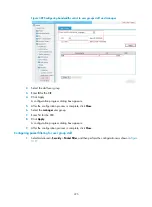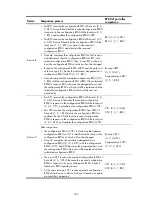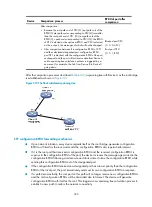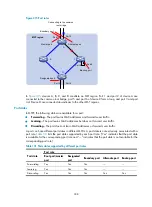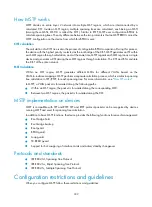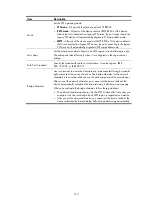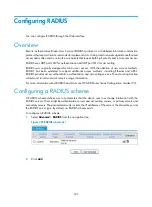
309
How MSTP works
MSTP divides an entire Layer 2 network into multiple MST regions, which are interconnected by a
calculated CST. Inside an MST region, multiple spanning trees are calculated, each being an MSTI
(Among these MSTIs, MSTI 0 is called the CIST). Similar to RSTP, MSTP uses configuration BPDUs to
calculate spanning trees. The only difference between the two protocols is that an MSTP BPDU carries the
MSTP configuration on the device from which this BPDU is sent.
CIST calculation
The calculation of a CIST tree is also the process of configuration BPDU comparison. During this process,
the device with the highest priority is elected as the root bridge of the CIST. MSTP generates an IST within
each MST region through calculation, and, at the same time, MSTP regards each MST region as a single
device and generates a CST among these MST regions through calculation. The CST and ISTs constitute
the CIST of the entire network.
MSTI calculation
Within an MST region, MSTP generates different MSTIs for different VLANs based on the
VLAN-to-instance mappings. MSTP performs a separate calculation process, which is similar to spanning
tree calculation in STP/RSTP, for each spanning tree. For more information, see "
In MSTP, a VLAN packet is forwarded along the following paths:
•
Within an MST region, the packet is forwarded along the corresponding MSTI.
•
Between two MST regions, the packet is forwarded along the CST.
MSTP implementation on devices
MSTP is compatible with STP and RSTP. STP and RSTP protocol packets can be recognized by devices
running MSTP and used for spanning tree calculation.
In addition to basic MSTP functions, the device provides the following functions for ease of management:
•
Root bridge hold
•
Root bridge backup
•
Root guard
•
BPDU guard
•
Loop guard
•
TC-BPDU guard
•
Support for hot swapping of interface cards and active/standby changeover
Protocols and standards
•
IEEE 802.1d,
Spanning Tree Protocol
•
IEEE 802.1w,
Rapid Spanning Tree Protocol
•
IEEE 802.1s,
Multiple Spanning Tree Protocol
Configuration restrictions and guidelines
When you configure MSTP, follow these restrictions and guidelines:
Summary of Contents for MSR SERIES
Page 17: ...xv Documents 835 Websites 835 Conventions 836 Index 838 ...
Page 20: ...3 Figure 3 Initial page of the Web interface ...
Page 42: ...25 Figure 13 Firefox Web browser setting ...
Page 59: ...42 Figure 27 Checking the basic service configuration ...
Page 73: ...56 Figure 35 Sample interface statistics ...
Page 156: ...139 Figure 139 Rebooting the 3G modem ...
Page 168: ...151 Figure 152 Configuring Web server 2 ...
Page 174: ...157 Figure 158 Configure the URL filtering function ...
Page 242: ...225 Figure 233 Enabling the DHCP client on interface Ethernet 0 1 ...
Page 247: ...230 Figure 236 The page for configuring an advanced IPv4 ACL ...
Page 255: ...238 Figure 241 Advanced limit setting ...
Page 298: ...281 e Click Apply 2 Configure Router B in the same way Router A is configured ...
Page 400: ...383 Figure 387 Verifying the configuration ...
Page 405: ...388 ...
Page 523: ...506 Figure 530 Ping configuration page ...
Page 775: ...758 Figure 785 Configuring a jump node ...

